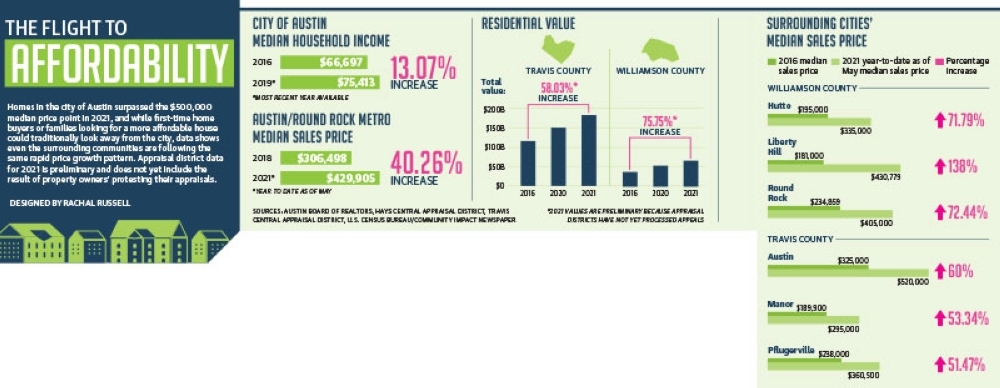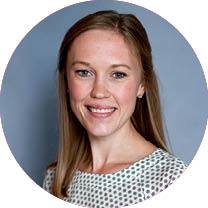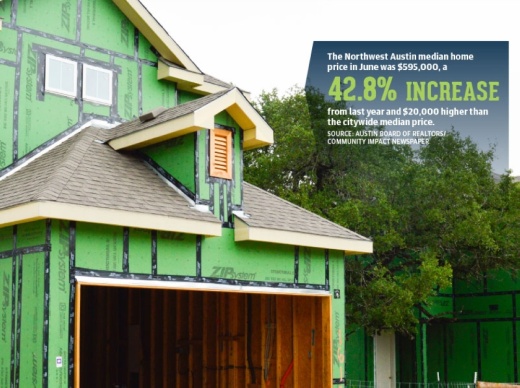But something happened around the middle of 2020 that pushed the market to take off, according to Realtors and economists.
Due to the increase in telework brought on by the COVID-19 pandemic, they said, many employees now working remotely moved in from other, more expensive, cities, no longer tied to their commutes. Locally, employees using their homes as office space thought differently about their needs. While unemployment levels reached the double digits nationwide, those who kept jobs built up disposable income.
“We were the hottest market, and we essentially dumped gasoline on it,” Bramlett said.
Before July 2020, the monthly median home sales price in the Austin-Round Rock metropolitan area had never reached $350,000. It surpassed $400,000 in March 2021, then reached $465,000 in May, the most recent month data is available from the Austin Board of Realtors. That is a 27.4% increase from January.
“You don’t have to have a Ph.D in economics to understand that if prices go up faster than incomes and home affordability is based on the relationship between income and price, then [homeownership is] becoming less affordable,” said James Gaines, research economist at Texas A&M University’s Texas Real Estate Center.

That breakneck pace of price increases cannot last forever, ABoR president Susan Horton said.
Eventually, she said she expects the price to return to some level of normalcy, although that could take years as supply catches up with demand.
“The builders can’t build [homes] fast enough to get us where we need to be to accommodate the growth into the metropolitan area,” Horton said.
‘Perfect storm’ of construction challenges
Even with demand potentially leveling off after the pandemic as individuals begin reprioritizing their spending habits, increasing supply remains difficult for many builders.
Aaron Boenig is the co-president of Brohn Homes, a developer that focuses on homes that are in the price range for first-time homebuyers. The company builds in areas less expensive than Austin such as Georgetown and San Marcos, but Boenig said it is increasingly difficult to build at a mid-range price point even in outlying areas.
Land prices are one factor that is making it harder for developers to build affordable homes, but Boenig said buying the land is only one challenge. Long waits for building permit approvals, the jump in materials prices—especially lumber—and labor shortages are also affecting developers. Boenig called it a “perfect storm” that is restricting supply.
In the Austin metro as of May, there were 0.5 months of inventory available, according to ABoR, a measure of how long it would take to sell all existing properties on the market. A balanced market, according to Gaines, has about five to seven months of inventory available.
“I think this is unprecedented, the way builders are selling homes, I’ve never seen anything like it in this industry,” Boenig said.
While Brohn Homes focuses on the outlying areas of Austin, Cody Carr’s family-owned business, Carr Residential, has been building new homes in Austin since 2015. Carr said he has seen a lot of the same challenges, including a tripling of the price of lumber since before the pandemic.
The company targets the $400,000-$1 million range for homes it builds, but Carr, who is also president of the Austin Infill Coalition, said it is becoming more and more difficult to stay in that range. A house Carr Residential could have built to sell in the high $300,000 range about five years ago, he said, would cost $500,000 today.
“I’m an Austinite. As an Austinite it’s difficult for me to watch the price of housing increase so dramatically. My own friends and family are having trouble finding a place to live,” he said.
Alternatives to single family
 Adrianne Craft, a real estate broker who is licensed with Keller Williams Realty, agreed buyers are having a truly difficult time finding homes.
Adrianne Craft, a real estate broker who is licensed with Keller Williams Realty, agreed buyers are having a truly difficult time finding homes.“A year ago, I would say that buyers could be a little bit pickier as far as the condition of a home goes,” Craft said. “A buyer may choose a house over another house because it doesn’t have carpet or it has white cabinets. ... Whereas now, buyers are having to just concede on everything.”
Craft added that every deal she has brokered this year has seen multiple offers for which homes are typically selling for 10%-20% over asking price. In addition to highlighting the current seller’s market, this is a situation that frequently does not favor first-time buyers, especially those seeking single-family homes, which account for the vast majority of homes on the market at any given time, she said. ••One solution officials in cities throughout the Greater Austin metro area have been examining over the last several years involves diversification of home types.
Dan Parolek, CEO of Opticos Design, a California firm that helps collaborate on housing and community issues, has given many presentations to city officials throughout Central Texas from New Braunfels to Austin.
Parolek’s presentations center on a concept called missing middle housing. This involves homes such as duplexes and townhouses to buildings with eight units. They are usually walkable, meaning they are located near business or city centers that have popular amenities.
These options, Parolek said, offer more affordability for people including first-time buyers who cannot make cash offers in order to become homeowners.
“Every market, regardless of how big the city, has been impacted pretty dramatically by the increase in costs,” Parolek said. “It’s become harder for ... sort of entry-level households to purchase homes.”
While Parolek agrees that single-family homes are the most abundant option for homebuyers, he said his research has shown that they are not necessarily the most popular option. He added that 60% of all housing throughout the country will need to be missing middle housing by 2040 in order to keep up with demand.
“I think there will continue to be a demand for single-family detached [homes], but I think more and more there is a growing demand that is not being met for these missing middle housing types,” he said. “I’m not saying there is not a demand for single-family, but historically that is all we’ve been delivering, and the industry is having a hard time sort of adjusting and shifting quickly enough to meet the demand.”
Smaller cities see big growth
When Robin Sheppard sold her Austin home of 35 years in December, she said she did not anticipate that she would still be searching for a house more than six months later.
Increasing tax rates, heavy traffic and rapid growth within Austin played a key role in Sheppard’s decision to leave the capital and move to San Marcos. She would still be close enough to visit friends but in a less crowded city, she said.
“I had lived in Houston for many years, and I left there to come to Austin because Austin was a lot smaller and had a wonderful feel to it,” Sheppard said. “This is not the Austin I came to.”
Within 2 1/2 days of listing her home, Sheppard received seven bids and accepted an offer that was $50,000 over asking and included a contingency that allowed her to live in her home rent-free for 30 days after closing.
“I just thought, ‘Wow this is great; now I can go and buy myself a house and have extra left over to travel,’ ... but that wasn’t the way it was,” Sheppard said.••By June, Sheppard had placed bids on more than six properties that met her requirement for an accessory dwelling unit she plans to rent for a low cost to a friend. Despite offering $42,000 over asking on one property, she has been outbid every time. ••Many homebuyers who plan to move to one of the smaller cities along the I-35 corridor expect to find more availability at a lower price point than in larger metro areas, said Patricia Fernandez, 2021 board president for the Four Rivers Association of Realtors. However, skyrocketing demand and dwindling supply have made once affordable markets highly competitive.
“You can pick any town in this corridor, and it’s the same story,” Fernandez said, adding buyers who qualified at one point for a house worth $350,000, for example, may have to place bids for homes listed in the high $200,000 range with the expectation of paying significantly more. “That whole middle market [is] just now getting wiped out of the playing field.”
As the population growth of cities on I-35 continues to outpace supply and corporations such as Amazon and Tesla invest in Central Texas, Fernandez expects to see interest grow in towns east of the interstate.
“[East] is the only direction you can go right now, because even as far as Waco it is the same exact market we are having,” Fernandez said.
Like many searching for a house, Sheppard said that if it came down to it, she would resort to renting in San Marcos if she could not find a permanent home soon.
“I feel like I’m homeless, you know; it just doesn’t feel good,” Sheppard said. “At the end of this month if I don’t have [a house], then I will rent something. ... I’m not looking forward to that, but that’s certainly going to have to be the next step. I can’t indefinitely be staying in other people’s homes.”







